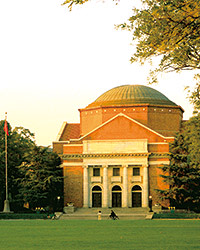What the 2015 Executive MBA survey reveals

Roula Khalaf, Editor of the FT, selects her favourite stories in this weekly newsletter.
The 2015 FT Global Executive MBA ranking this year is remarkable for two reasons. Not only is it the FT’s 100th ranking of business schools, but it also marks the first time that a programme that includes a mainland Chinese business school has occupied the top position.
The joint programme delivered by Tsinghua and Insead University (Tiemba) moved up two places to lead the 2015 global executive MBA ranking, dethroning Trium, which drops back to third place after only one year at the top.
The EMBA ranking rates the best 100 programmes worldwide for working senior executives. The ranking is based on a survey of business schools as well as their students who graduated in 2012. The data measure how successful alumni have been in their career in terms of salary, seniority and achievements since graduating.
For the fourth year in a row, the top five places continue to be dominated by the same five intercontinental EMBAs. Tiemba came top this year not by spectacularly outperforming its rivals but thanks to a strong performance across most indicators. In particular, the alumni have the second highest salary on average ($324,000) behind alumni from the Kellogg/HKUST programme ($408,000). Tiemba is also ranked second for career progression and fourth for work experience.
Five schools from five different countries are ranked for the first time. Singapore’s Lee Kong Chian School of Business is the highest new entrant coming straight into 36th place. Canada’s Queen’s Smith School of Business registered the best progression, climbing 32 places to 67th.
Overall, starting a company ranked lowest among reasons cited for undertaking an EMBA (rated 5.5 out 10). Students’ main motivations were learning about management (9.1), networking (8.3) and increasing earnings (8.1).
While 17 per cent of graduates rated starting a company as joint most important reason, only 2 per cent of them saw it as their main sole ambition. However, entrepreneurship is clearly growing on them, as more than a quarter of graduates (26 per cent) reported starting their own company during their EMBA or since graduating.
Nearly all the entrepreneurs (93 per cent) rated their new skills as important or very important in their decision. “I understand the value of my skills without the ‘fear’ of not being employed,” said one.
Also important to EMBA entrepreneurs was the support of their school and alumni network. About three-quarters of entrepreneurs thought that both the school and their alumni network were helpful or very helpful when setting up their company. “Alumni support was key to getting the idea vetted and getting the right contacts needed for the business”, said one.
About 40 per cent of entrepreneurs did not seek any help when securing finance. Half of these raised equity purely from their own savings and/or family and friends compared with only 40 per cent of those who sought help from the school or alumni network.
About 40 per cent of entrepreneurs derive most of their income from their company with an average salary of about $194,000 compared to $171,000 for non-entrepreneurs. Entrepreneurs in Asia/Oceania seem to be the most successful. Nearly half (48 per cent) of them earn most of their income from their company and earn the highest salary ($251,000 on average), just ahead of those based in the Middle-East ($244,000).
Top programme: Tsinghua/Insead

The Tsinghua-Insead EMBA programme, launched in 2007, entered the FT rankings with a bang in 2012, going straight into fourth place with its very first cohort. The programme has since been ranked second, third, and finally has achieved first place in the rankings this year.
Tiemba scores highly for international experience, being delivered half on Tsinghua’s campus in Beijing as well as on Insead’s three campuses in Singapore, France and the UAE.
The programme is ranked second for career progress three years after graduation. Tiemba’s graduates number only about 250 so far, making them an elite group.
New entrant to the top 10: Saïd

Breaking into the top 10 for the first time, Saïd’s EMBA programme jumped 12 places to achieve 9th spot in the rankings. The programme entered the rankings in 2010 and has gradually been improving since sinking to a low of 38th place in 2012.
Saïd has the highest ranked single EMBA programme in the UK and second highest in Europe behind Spain’s IE Business School. The graduates have, on average, the highest salary three years after graduating, compared with graduates from other British schools, and the second highest salary increase.
Entrepreneurship is a key feature of the programme, with more than half the graduates starting their own company.
Top for international students: LBS

In an increasingly globalised world, many business schools are looking to add elements that ensure their programmes are relevant internationally. The one to beat this year is London Business School’s EMBA programme, which is ranked 19th overall, but first for international diversity for the second year.
The programme is divided into two cohorts based in London and Dubai. In the latest enrolled cohort, about 90 per cent are international students and they come from 52 countries.
Students from India represent the single largest grouping from one country (14 per cent of students). LBS also has a high proportion of students from the Middle East.
Highest new entrant: Singapore Management University: Lee Kong Chian

Making its debut at number 36, the Singapore-based programme is the highest-ranked of five EMBAs entering the ranking for the first time.
Applicants for the SMU EMBA must have at least 10 years of professional experience before enrolling. The programme, therefore, has among the most experienced students in the ranking.
The S$109,500 degree involves six weeks at the Singapore campus, plus three week-long immersions around the world. As well as Peking University in China and the Indian School of Business, participants also visit the University of Pennsylvania’s Wharton school, on which SMU is itself modelled.
Highest riser: Queen’s University: Smith

The Ontario school’s EMBA programme is one of six offered by Canadian universities to make it into this year’s top 100.
After a 32-place leap in ranking to number 67, the course is now only 14 places behind Queen’s joint EMBA with US university Cornell. Costing C$98,000, it is a little less than C$32,000 cheaper than the joint programme.
Students can attend classes during the 16-month programme from anywhere in Canada, interacting through real-time video conferencing. For those who cannot join peers in one of the “boardroom learning centres”, they can log in from home, but all students must attend some classes in Kingston, Ontario.
Top South American: Centrum Católica

The Peruvian business school is one of two South American institutions represented in the FT’s 2015 ranking, and is ranked 52nd, the same position as last year.
The 18-month EMBA is based in Peru’s capital, Lima, with three out of eight modules taught overseas. As well as visiting China, students attend classes at IE Business School in Spain and Tulane University’s Freeman school in New Orleans — a strategic partner of Centrum Católica.
Centrum is the graduate business school of the Pontifical Catholic University of Peru, the country’s oldest private university, which celebrates its 100th anniversary in 2017.
Comments